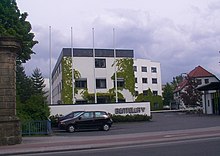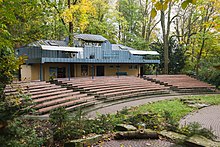Neuhaus Castle (Paderborn)
|
Neuhaus Castle
City of Paderborn
|
|
|---|---|
| Coordinates: 51 ° 44 ′ 39 " N , 8 ° 42 ′ 46" E | |
| Height : | 102 m above sea level NN |
| Area : | 26.04 km² |
| Residents : | 25,533 (Dec. 31, 2012) |
| Population density : | 981 inhabitants / km² |
| Incorporation : | 1st January 1975 |
| Postcodes : | 33104, 33102 |
| Area code : | 05254 |
|
Location of Neuhaus Castle in Paderborn
|
|
Since its incorporation in 1975, Neuhaus Castle has been a northern part of Paderborn in the east of North Rhine-Westphalia with around 25,500 inhabitants; it also includes the districts of Sennelager and Mastbruch .
The Neuhaus municipality, which was independent until 1974, was the seat of the Neuhaus office for a long time , to which Elsen and Sande still belonged. On September 10, 1957, after the celebration of the 700th anniversary of the castle, the municipality and office were given the name “Castle”. The castle in Neuhaus was the residence of the prince-bishops of Paderborn until 1802/03 .
location
The Paderborn district together with Sande and Sennelager form the city district of Schloss Neuhaus / Sande. Neighboring - starting in the north in a clockwise direction - are the municipality of Hövelhof , the city of Bad Lippspringe and the Paderborn districts of Marienloh , Kernstadt, Elsen and Sande .
The place owes its name to the castle located at the confluence of the Alme , Lippe and Pader rivers and extends south and east of it. It is surrounded by greenery , both by the castle and meadow park and its northern extension to the Lippesee, and by the Paderborn city forest to the south; the light, newer development, predominantly with one- and two-family houses, only touches the Paderborn city center in a few places.
history
Neuhaus is first mentioned in 1016 in the "Vita Meinwerci", written by Abbot Konrad von Abdinghof after 1165, the biography of Bishop Meinwerk (1009-1036). It was first mentioned in a document in 1036. A dispute between the episcopal sovereign and the population of the city of Paderborn led to the fact that the former castle between the three rivers became an episcopal residence. From 1370 to the secularization of 1802/03, the bishops of Paderborn administered their prince-bishopric from Neuhaus Castle .
The castle was confiscated by British forces after the Second World War , but returned to the community on July 19, 1964. Today it is used by a municipal secondary school and houses representative rooms for the city of Paderborn.
Neuhaus Castle is also affected by the flood disaster in the Paderborn district on July 16, 1965 . Farmers fight desperately to save their cattle from the pastures. As a result of this environmental disaster, Schloss Neuhaus lost two lives.
Neuhaus Castle was the seat of the Neuhaus Castle Office until the end of 1974 , which also included Elsen , Hövelhof and Sande and until 1969 Stukenbrock .
It was incorporated into the city of Paderborn as part of the Sauerland / Paderborn law on January 1, 1975 together with Sande as the city district of Schloss Neuhaus / Sande . Both places are still counted as two districts.
In 1994 Paderborn hosted the North Rhine-Westphalia State Horticultural Show at Neuhauser Castle.
In 1995 the Federal Festival of the Federation of Historical German Rifle Brotherhoods took place at the same location. The organization of this festival for 2019 was also awarded to the Bürger-Schützen-Verein Schloß Neuhaus 1913 as the largest brotherhood of the Federation.
religion
For the mostly Catholic population, there were three Catholic parishes in the area of the former political community of Schloss Neuhaus until the end of 2015 , all of which belonged to the Paderborn deanery in the Archdiocese of Paderborn . In the town center of Neuhausen there was St. Heinrich and Kunigunde , in Mastbruch St. Joseph (these two parishes were merged into a pastoral association in 2002), in Sennelager St. Michael . On January 1, 2016, these three parishes and the St. Marien parish of Sande were merged to form the Catholic parish Parish of St. Martin von Tours by a documentary resolution of the Archdiocese of Paderborn.
The Protestant parish of Schloss Neuhaus belongs to the Paderborn parish of the Evangelical Church of Westphalia and also includes Sennelager and Sande. In Sennelager there is the Paul Gerhardt Community Center.
The Catholic and Protestant parishes jointly publish a newsletter.
District committee Schloss Neuhaus / Sande
After the last municipal elections in 2015, the 18-member district committee for Schloss Neuhaus / Sande was composed as follows:
- CDU : 9 seats
- SPD : 4 seats
- Greens : 2 seats
- FBI : 1 seat
- FDP : 1 seat
- DIP : 1 seat
- Chairman: Michael Pavlicic (CDU)
Culture and sights
In the Neuhauser Schlosspark there is a historical and a natural history museum in the stables, and there are special exhibitions several times a year. The former riding arena was transformed into today's castle hall between 1989 and 1993, under the responsibility of the Bürgerhausverein e. V., rebuilt.
The annual "Castle Summer" attracts many visitors from near and far to the castle park with numerous events and cultural events. Plays for adults and children are regularly performed on the open-air stage at Schloss Neuhaus , with great public response.
The Neuhäuser Schützenfest of the St. Henricus Brotherhood e. V. takes place as a large folk and family festival on the first weekend in June. The international cultural exchange for street theater and puppet shows “Performance” at the end of August

Buildings
The place is named after Neuhaus Castle , which was built in the Weser Renaissance style between 1524 and 1526 . Until the secularization of 1802 it was the seat of the Paderborn prince-bishops , after which it was used for military purposes, initially by Prussia and 1945–1964 by the British Army of the Rhine . Today the castle houses a secondary school and representation rooms for the city of Paderborn.
The cath. The parish church of St. Heinrich and Kunigunde was built in 1665/66 as a hall building in Gothic style instead of an older Ulrich church. The transept, the upper floor of the tower and the choir were not added until 1934–36. The simple, plastered exterior is only enlivened by the baroque column portals with the coat of arms of Prince-Bishop Ferdinand von Fürstenberg . Most of the furnishings date from the time the church was built: the high altar was made in 1667, the organ front was made in 1680.
In the historical center in the vicinity of the castle, the character of the small residence has been retained to some extent despite numerous changes. The following examples are to be highlighted from the residential development of half-timbered houses at that time:
- Am Ringgraben 13 : half-timbered house from 1677.
- Padulusstrasse 4 : three-storey building with a half-hip roof and carved portal, marked 1596
- Residenzstrasse 14 : Small two-storey gabled house with crossed struts, marked 1731.
- Residenzstrasse 37 , with a mansard roof, marked 1701.
- Schloßstraße 6 : hall house with utlucht , marked 1694.
The forest cemetery (located between Dubelohstraße, Schatenweg, Josef-Temme-Weg and Hatzfelder Straße) is also classified as a monument. a. Heinz Nixdorf is buried.
Economy and Infrastructure
The largest company in the area is Benteler International AG with two plants in Schloss Neuhaus (in the old town center and on the valley). Benteler employs approx. 30,000 employees.
traffic
In Schloß Neuhaus there is a junction of the A 33 on the B 64 leading to Delbrück as well as a driveway on Dubelohstraße on the B 1 , which is developed here as an expressway in a 2-to-1 system and the district of Schloß Neuhaus is undeveloped Crossed south without crossing.
Numerous Paderborn local bus routes connect Schloss Neuhaus with the other Paderborn districts.
The route of the Senne-Bahn Paderborn-Bielefeld runs through the district; The former Schloß Neuhaus train station near the Benteler plant was dismantled as an alternative connection point in the early 1980s , but the plant continues to be served by rail freight traffic. Between Schatenweg and Hatzfelder Straße, the new stop (Paderborn-Neuhaus Castle) with access to Schatenweg has been in operation since October 30, 2008 ; access from Hatzfelder Straße has not yet been completed due to land disputes. The service takes place every hour - even on weekdays with half-hourly offers on the Senne-Bahn.
Sports
The SC Paderborn 07 played until the end of the 2007/2008 season in the Hermann-Löns-Stadion in Neuhaus Castle. At the beginning of the 2008/2009 season, the SCP moved into the newly built Paragon Arena (since July 2012: Benteler Arena ), which is also located in the Neuhäuser district .
Personalities
Sons and daughters of the place
- Friedrich Wilhelm Adam Sertürner (1783–1841), pharmacist, discoverer of morphine
- Eduard von Raven (1807–1864), Prussian major general, commander of the 10th Infantry Brigade
- Karl Freiherr von Plettenberg (1852–1938), Prussian infantry general , commanding general of the Guard Corps and adjutant general of Kaiser Wilhelm II.
- Heinrich Vockel (1892–1968), politician, first Berlin representative of the Federal Government
- Engelbert Westkämper (* 1946), Professor of Production Technology and Factory Operations and Head of the Fraunhofer Institute for Production Technology and Automation (IPA), Stuttgart
- Gabriele Buschmeier (1955–2020), musicologist
- Joachim Negel (* 1962), Roman Catholic fundamental theologian
- Oliver Reese (* 1964), theater director, dramaturge and author
Personalities who have worked on site
- Josephus Simon Sertürner (1729–1798), surveyor, engineer, architect
- Gustav Waldemar von Rauch (1819–1890), Prussian lieutenant colonel and 1860–1862 commander of the hussar regiment “Emperor Nicholas II of Russia” (1st Westphalian) No. 8 , later general of the cavalry
- Matthias König (* 1959), auxiliary bishop in Paderborn, previously pastor in Neuhaus Castle until 2005
literature
- Nienhuss . In: Topographia Westphaliae ( Matthäus Merian ) on Wikisource
Web links
- Neuhaus Castle district. City portal Paderborn
- Neuhaus Castle open-air theater
- Schloss-Neuhaus in the Westphalia Culture Atlas
Individual evidence
- ↑ Published in the Ministerialblatt NRW 1957, p. 2006 according to a notification from the Paderborn City Archives of January 4, 2011
- ↑ Stephanie Reekers: The regional development of the districts and communities of Westphalia 1817-1967 . Aschendorff, Münster Westfalen 1977, ISBN 3-402-05875-8 , p. 279 .
- ^ Federal Statistical Office (ed.): Historical municipality directory for the Federal Republic of Germany. Name, border and key number changes in municipalities, counties and administrative districts from May 27, 1970 to December 31, 1982 . W. Kohlhammer, Stuttgart / Mainz 1983, ISBN 3-17-003263-1 , p. 328 .
- ↑ International Culture Exchange - Performance








